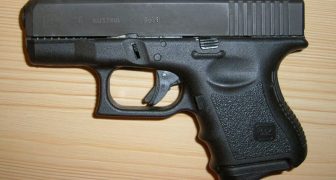by Home Defense Gun Staffer Bob
Glock’s Pocket Pistol
The ebb and flow of gun design has always interested me. For some reason the gun industry likes to take a concept, fuss with it, rework it and redefine it until the initial guns in the genre have little resemblance to their current brethren, at which point they move back toward the originals with “retro” designs. One area of firearms in which this behavior is most noticeable is with that collection of small semi-automatic guns we refer to as “pocket pistols”.
Most of the original pocket pistols were the product of collaborations between Colt and John Browning. These guns we skinny, slick and  easily concealable with their popularity hitting an all-time high roughly around 1925, long before anyone came up with the idea of concealed carry permits. The original pocket pistols weren’t really meant to be “hideout guns”, they just allowed you to have a gun when wearing a big one on your hip might be a little undignified. The success Colt had with these guns even lured a few other companies, such as Remington and Savage, into producing them, even though pistols weren’t their traditional products.
easily concealable with their popularity hitting an all-time high roughly around 1925, long before anyone came up with the idea of concealed carry permits. The original pocket pistols weren’t really meant to be “hideout guns”, they just allowed you to have a gun when wearing a big one on your hip might be a little undignified. The success Colt had with these guns even lured a few other companies, such as Remington and Savage, into producing them, even though pistols weren’t their traditional products.
Thankfully, Glock has solved my pocket pistol problem with the introduction of the Glock 42, chambered for the .380 Auto. The new 42 is just as modern as any Glock, but puts me in mind of the pistols from almost a century ago. This new Glock is a bit of a throwback in the sense that it is an adult-sized pocket pistol, much like the old Colts. Even a guy like me with slightly oversized hands can get a grip on it without the gun disappearing or worrying over how to squeeze the trigger. While it’s big enough to handle well, the gun’s single-stack magazine and short height place it firmly in the pocket pistol category. This is a gun that can be tucked in your waistband and ride there all day without a thought.
Down at the SHOT Show this year I got the chance to check out the new Glock and strip it down to see how it worked. Most booth workers down in Vegas kind of frown on you taking their display models apart, but if you’re quick about it and can manage to get the thing back together they don’t get too grumpy with you. In the case of the Glock 42 I wasn’t too worried because Glocks aren’t really what I’d call complicated, and it was non-negotiable anyway because I had to know if the 42 was a blowback gun. It’s not, really, it’s just a smaller version of the Glocks that came before it. This means that there aren’t any departures from Glock’s tried and true design, making the 42 an extremely trustworthy pocket gun.
By and large I always have a hard time shelling out for small caliber guns or small frame guns. I find one I like and always end up asking myself if it will really be any easier to conceal or offer as much utility as the large frame autos I usually carry. This thinking usually leads to me passing on the purchase, but the Glock 42 may be tempting enough to bump me out of this rut.
For starters, the 42 isn’t that expensive of a gun. Most of the specimens I’ve been looking at retail for around $450, which isn’t that bad for a well-made pistol like a Glock. Second, the 42 really is easier to carry and conceal than a large frame auto. The 42’s reduced size makes it perfect for hiding under a shirttail and its low weight makes it an excellent choice for the new concealed carry undershirts that are becoming so popular these days. Finally, the 42’s greatest selling point might be that it’s a Glock.
There are any number of other pocket pistols on the market that are essentially scaled down versions of their large frame ancestors but a lot of those designs don’t really work that well in scaled-down form. The Glock is an extremely reliable platform which is the primary concern with a pocket gun. While we’d all like our concealed carry gun to be light, accurate and easy to carry, reliability is always the most sought after component. The Glock 42 can offer this over the other guns in the field. Heck, if nothing else it will be interesting to see if Glock’s single-stack magazines last as well as their double-stacks do.What are your experiences with pocket pistols? Let us know in the comments.
Photo Credit – Hyatt Guns
Photo Credit – Adams Guns


Speak Your Mind